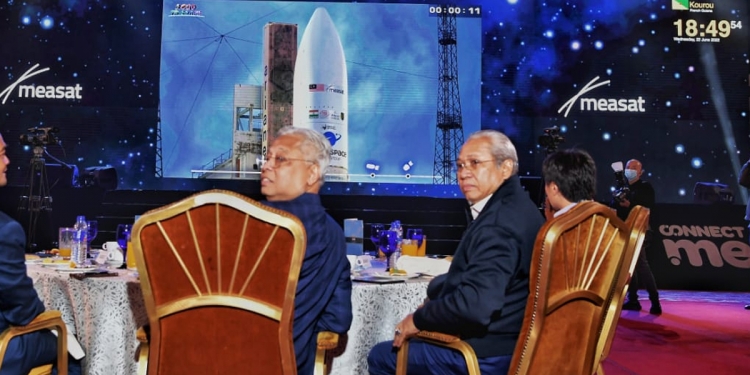MEASAT’s 8th satellite, the MEASAT-3d, has successfully launched into space this morning at 5.50am Malaysian time. It was a pretty significant event, with everyone from Prime Minister Dato’ Sri Ismail Sabri to us in the office getting up early to catch the launch. With MEASAT-3d now in orbit though, the goal is for it to spur Malaysia’s internet to have a 100% coverage by 2025.
According to Communications and Multimedia Minister Tan Sri Annuar Musa, MEASAT-3d will be playing an important role in improving the quality of Malaysia’s broadband services, and will help Malaysia achieve a 100% Internet coverage by 2025. It’s deemed a crucial piece of the puzzle in the government’s efforts to complete the JENDELA program and the Malaysian Digital Economy Blueprint (MyDigital), and with MEASAT-3d they will be able to bring internet access to rural areas.
Alhamdulillah Satelit MEASAT-3d selamat dilancarkan.Insyaallah ia memungkinkan perkhidmatan Jalur Lebar satelit negara terus di pertingkatkan dari segi capaian dan dengan keupayaan lebih tinggi. pic.twitter.com/K1ZLqAS5kg
— Annuar Musa (@AnnuarMusa) June 22, 2022
“So, there are two important aspects relating to the launch of the satellite today. Firstly, it will enable us to achieve 100 per cent Internet coverage for all populated areas before 2025.
And secondly, we will be able to improve the quality of broadband services, improve high-speed services to be as good as the fibre optic network that we are implementing in developed areas,” – Annuar Musa
The satellite will now go through a process where it will be raised from a geo-transfer orbit into a geostationary orbit at the 91.5°E hotslot together with MEASAT-3a and MEASAT-3b. MEASAT-3d will then undergo testing for approximately one month before it is brought into commercial operations.
Annuar Musa claims that Malaysia currently has an expected Internet coverage of up to 97% under the JENDELA program, but rural areas remain the biggest challenge right now. There already are some satellite internet services available in Malaysia, but the Communications and Multimedia Minister claims that these are only of low capacity and low speeds of below 10Mbps. This is despite MEASAT’s Connectme service offering satellite broadband with speeds up to 25Mbps, though is relatively expensive starting at RM198/month. There’s also the Connectme Now prepaid satellite broadband service offering speeds of up to 30Mbps which rural folks can get via prepaid vouchers at RM10 per GB. Connectme Now can be deployed into a rural area as long as there’s at least 100 people living there and there’s no 4G or 3G signal as well as space to install the required equipment. MEASAT-3d though will be able to bring 35Mbps to 100Mbps internet to the remaining 3% of Malaysia without internet right now.
That 100% target certainly does seem a tad too optimistic though if we’re talking about internet penetration, considering that by all accounts no country has so far achieved that figure. The countries with the highest internet access rates are Denmark, the UAE and Ireland, with a 99% of their population accessing the internet. The Department of Statistics recently reported that the percentage of households that have access to the internet sat at 95.5% by the end of 2021. It could be argued that reaching 100% is possible if you only refer to internet coverage by area, but whether Malaysians are actually able or willing to access it or not is a different matter; although MEASAT satellites cover all of Malaysia, right now accessibility depends on Connectme sites being deployed in rural areas.
VA257 liftoff captured from Kourou Space Centre. The Ariane 5 rocket carries both Malaysia's MEASAT-3d and India's GSAT-24 satellites. https://t.co/rRiymcSPTl pic.twitter.com/xmcvPkzGoe
— SoyaCincau (@Soya_Cincau) June 22, 2022
Despite the ambitious goal, the government has not shown any plans to provide funding to accelerate deployment of satellite sites in these rural areas. During the launch event in French Guiana, the Secretary General of Communications and Multimedia Ministry Dato’ Sri Haji Mohammad Mentek said that there’s no USP fund or initiatives for satellite service in rural areas, as USP is only for telcos at the moment.
Members of the SoyaCincau team were also there at Kourou, French Guiana to witness the historic event. We’ve got extensive coverage of the MEASAT-3d launch, and you can click here to read more about Malaysia’s latest satellite.








